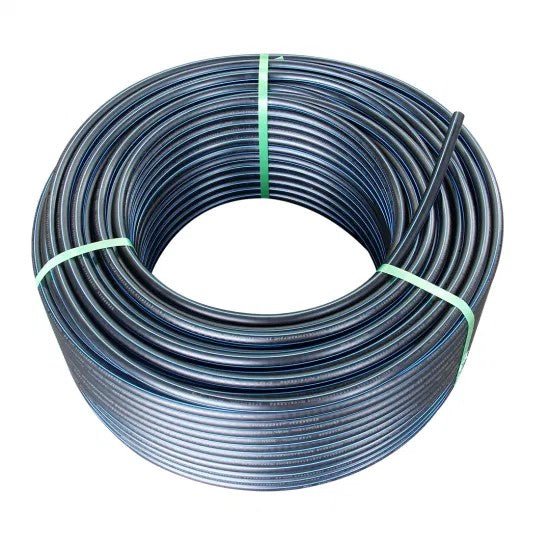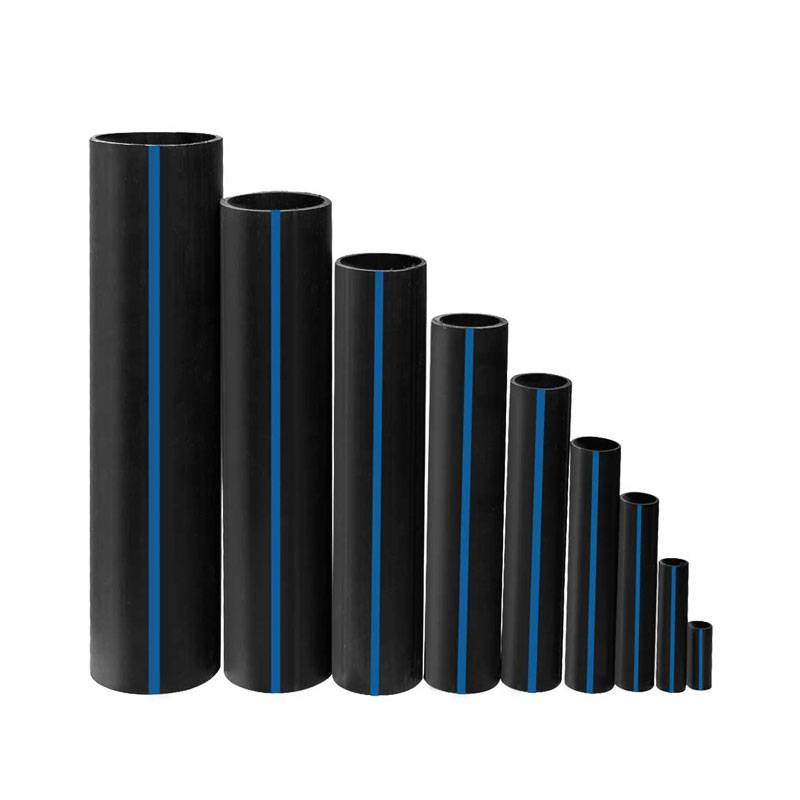custom hdpe pipe manufacturing Midland TX: Trends Shaping the Market
Check Out the Manufacturing Process Behind High-Quality HDPE Pipeline and Its Applications
The production procedure of top notch HDPE pipes is detailed and systematic. It begins with the selection of basic materials that enhance efficiency. Following this, ethylene goes through polymerization to develop resin, which is after that formed via extrusion. Quality assurance is vital, guaranteeing that the end product fulfills rigid criteria. The trip of HDPE pipelines doesn't end with manufacturing. Their applications throughout various sectors expose a broader relevance worth analyzing.
Comprehending HDPE: Characteristics and Advantages

High-density polyethylene (HDPE) is a flexible polycarbonate known for its longevity and resistance to different environmental aspects. This product displays excellent tensile strength, making it suitable for demanding applications. Its low-density structure adds to a light-weight product, helping with simplicity of managing and installment. HDPE additionally showcases remarkable resistance to chemicals, which reduces deterioration when subjected to rough substances.
The material's low dampness absorption better boosts its long life, making it perfect for use in pipes and storage tanks. In addition, HDPE is resistant to ultraviolet (UV) radiation, making sure that products keep their stability even when subjected to sunshine. Additionally, its flexibility enables the production of complex forms without jeopardizing toughness. The environmentally friendly nature of HDPE, commonly originated from recycled materials, contributes to its charm, advertising sustainable techniques in production. Overall, these buildings and advantages make HDPE a favored option for different industrial and customer applications.
Raw Material Option for HDPE Manufacturing
The choice of resources for HDPE production is necessary to validate the end product satisfies the preferred specifications and high quality criteria. High-density polyethylene (HDPE) is largely created from polymerized ethylene, stemmed from fossil fuels such as gas or unrefined oil. The top quality of these feedstocks greatly influences the mechanical and thermal residential or commercial properties of the last HDPE.
Additives also play a substantial function in boosting HDPE's performance, consisting of antioxidants, UV stabilizers, and colorants, which improve toughness and resistance to ecological variables. The option process need to take into consideration not only the chemical composition of the raw products yet additionally their processing characteristics to ensure effective manufacturing.
The sourcing of raw products ought to focus on sustainability and compliance with environmental regulations, as accountable practices are necessary in today's market. Inevitably, cautious raw product option lays the foundation for generating top quality HDPE pipelines ideal for diverse applications.
The Extrusion Refine: Shaping HDPE Pipeline
The extrusion process plays an important role in forming HDPE pipelines, starting with meticulous material preparation techniques that guarantee optimal flow and consistency. Equally vital is the layout of the die, which directly affects the final dimensions and surface area high quality of the pipe. With each other, these factors add significantly to the effectiveness and quality of HDPE pipe production.
Material Preparation Techniques
Reliable production of HDPE pipelines starts with precise material prep work strategies, specifically the extrusion process. During this stage, high-density polyethylene material is initial dried to remove dampness, making sure optimal flow characteristics. The material is then fed into the extruder, where it goes through heating and melting, changing into a thick state. This home heating procedure is carefully regulated to preserve the material's integrity and efficiency. The liquified HDPE is forced with a die, shaping it into a continuous pipeline type. Correct temperature administration throughout extrusion is important, as it straight impacts the material's residential or commercial properties and the last item quality. As soon as formed, the HDPE pipeline is cooled and reduced to defined lengths, prepared for subsequent handling and applications.
Die Design Importance
Accuracy in die design plays a necessary role in the extrusion process of HDPE pipes. The die acts as the last shaping device, directly influencing the pipe's dimensions, wall density, and surface area finish. A well-designed die guarantees consistent material circulation, lowering problems such as abnormalities and weak areas. The geometry of the die need to be optimized to suit the details properties of HDPE, including its viscosity and thermal behavior during extrusion. Furthermore, the cooling rate of the material as it passes through the die can substantially affect the pipe's architectural stability. Investing in innovative die innovation is crucial for manufacturers aiming to produce high-grade HDPE pipelines that satisfy sector standards and client assumptions.
Quality Assurance Measures in HDPE Manufacturing
Various variables influence the quality of HDPE pipeline production, efficient high quality control actions are vital to ensure uniformity and integrity in the last item (Texas hdpe pipe manufacturer). Secret high quality control practices include rigorous product examination, validating that the raw polyethylene fulfills well established requirements for pureness and density. Throughout the extrusion process, specifications such as temperature, stress, and cooling time are closely kept an eye on to keep dimensional accuracy and structural stability
Additionally, post-production screening is crucial; makers commonly carry out hydrostatic examinations to assess the pipe's strength and resistance to pressure. Visual examinations for surface issues better boost quality control. Accreditation from pertinent standards organizations, like ASTM or ISO, gives an added layer of trustworthiness. By implementing these detailed top quality control measures, makers can minimize flaws, improve performance, and guarantee that the HDPE pipes meet the details needs of different applications, ultimately bring about customer fulfillment and count on original site the product.
Applications of HDPE Pipeline Across Industries
HDPE pipes are used throughout numerous industries due to their toughness and versatility. In water circulation systems, they assure reliable delivery, while in wastewater management, they give dependable options for waste transportation. In addition, farming watering networks gain from HDPE's resistance to rust and adaptability, making it a perfect choice for modern farming practices.

Water Distribution Systems
A substantial number of industries rely upon high-density polyethylene (HDPE) pipelines for reliable water distribution systems. Understood for their resilience and resistance to deterioration, HDPE pipelines are widely utilized in local water networks, farming irrigation, and commercial applications. Their light-weight nature helps with very easy handling and setup, reducing labor prices and time. Furthermore, HDPE pipelines can fit different stress levels, making them suitable for both reduced and high-pressure systems. hdpe pipe in stock Midland TX. The flexibility of the material permits smooth integration right into existing framework, lessening the need for extensive excavation. Furthermore, HDPE's resistance to chemical leaching warranties that the water supplied stays risk-free and clean, making it an optimal choice for maintaining the top quality of safe and clean water throughout numerous markets
Wastewater Management Solutions
Effective water distribution systems likewise lead the way for ingenious wastewater monitoring remedies, where high-density polyethylene (HDPE) pipes play a considerable role. Popular for their resilience and resistance to deterioration, HDPE pipes are suitable for transferring wastewater in various setups. Their adaptability enables simple setup in complex environments, decreasing the requirement for extensive excavation. Furthermore, HDPE's smooth indoor surface minimizes rubbing, improving flow rates and performance. These pipelines are additionally resistant to chemical leaching, making certain that pollutants do not jeopardize the surrounding setting. Industries, districts, and therapy centers increasingly count on HDPE pipelines for their reliability and long life, making them a preferred selection for modern-day wastewater administration systems. This flexibility emphasizes the important significance of HDPE pipes throughout numerous applications.
Agricultural Watering Networks
Agricultural irrigation networks benefit significantly from using high-density polyethylene (HDPE) pipes, which give efficient and trusted water shipment to plants. HDPE pipes are lightweight, making them very easy to transfer and set up, while their versatility permits numerous setups in diverse surfaces. These pipelines demonstrate exceptional resistance to rust, chemicals, and UV radiation, ensuring longevity in harsh agricultural settings. Additionally, their smooth interior surface lessens friction loss, optimizing water flow and reducing energy prices related to pumping. The longevity of HDPE pipes, often going beyond half a century, contributes to lower upkeep and substitute expenses. Farmers progressively count on HDPE pipes to enhance irrigation effectiveness and advertise sustainable farming practices, eventually leading to boosted crop returns and resource conservation.

Future Patterns in HDPE Pipeline Innovation
As the need for sustainable and effective framework expands, innovations in HDPE pipeline modern technology are poised to transform numerous industries. Emerging trends consist of the integration of wise technologies, such as sensing units and IoT abilities, which facilitate real-time monitoring of pipe conditions, decreasing upkeep prices and avoiding leaks. Furthermore, the advancement of advanced production methods, such as 3D printing, is enabling the manufacturing of facility, tailored pipeline designs that accommodate specific job requirements.
The focus on recycling and circular economic situation practices is driving the development of HDPE pipes made from recycled products, enhancing sustainability. Enhanced jointing techniques, such as electro-fusion and mechanical installations, are also improving setup efficiency and dependability. The growing focus on ecological regulations is pressing manufacturers to take on greener manufacturing procedures, ensuring that HDPE pipelines not just satisfy sector standards yet additionally foster a more lasting future for infrastructure growth.
Often Asked Inquiries
Just How Does HDPE Contrast to Various Other Plastic Products?
HDPE outmatches several various sanitary piping other plastic materials relating to longevity, chemical resistance, and adaptability. Its low thickness and high tensile toughness make go now it excellent for different applications, typically surpassing alternatives in both efficiency and longevity.
What Are the Environmental Effects of HDPE Production?
The ecological effects of HDPE production include greenhouse gas exhausts, energy intake, and possible pollution from manufacturing procedures. Furthermore, improper disposal can result in dirt and water contamination, increasing concerns regarding lasting ecological results.
Can HDPE Water Lines Be Recycled?
Yes, HDPE pipes can be reused. Numerous centers approve used HDPE for handling, transforming it right into new products. This recycling contributes to sustainability initiatives, reducing plastic waste while preserving resources and energy in the production cycle.
What Is the Lifespan of HDPE Piping?

Exactly How Do Temperature Level Variants Affect HDPE Pipe Performance?
Temperature level variants substantially affect HDPE pipeline efficiency, affecting flexibility and toughness. High temperature levels can bring about softening, while low temperature levels may create brittleness, ultimately influencing the pipeline's toughness and viability for various applications in diverse settings.